Fractal Characteristics of Micro- and Mesopores in the Longmaxi Shale
Abstract
1. Introduction
2. Materials and Methods
2.1. Experiments
2.2. Multifractal Analysis
2.3. FHH and V-S Fractal Model
3. Results
3.1. TOC and XRD Analysis
3.2. N2 and CO2 Adsorption
3.3. Multifractal Parameters
3.4. FHH and V-S Fractal Dimension
4. Discussion
4.1. Pore Structure Parameters and Their Controlling Factors
4.2. Multifractal Characteristics of Micropores and Mesopores
4.3. Association between Fractal Dimensions
4.4. The Relationship between Fractal Parameters and Shale Transport Properties
5. Conclusions
Author Contributions
Funding
Acknowledgments
Conflicts of Interest
Abbreviations
| TOC | Total organic carbon content, % | DTN | D−10–D10 of mesopores, dimensionless |
| Qtz | Quartz content, % | DPN | D0–D10 of mesopores, dimensionless |
| Fsp | Feldspar content, % | DNN | D−10–D0 of mesopores, dimensionless |
| Cb | Carbonate content, % | D1C | Information dimension of micropores, dimensionless |
| Clay | Clay content, % | HC | Hurst index of micropores, dimensionless |
| PV1 | Mesopore pore volume, cm3/g | DTC | D−10–D10 of micropores, dimensionless |
| PV2 | Micropore pore volume, cm3/g | DPC | D0–D10 of micropores, dimensionless |
| SSA | BET specific surface area, m2/g | DNC | D−10–D0 of micropores, dimensionless |
| D1N | Information dimension of mesopores, dimensionless | DN1, DN2 | FHH fractal dimension of mesopores, dimensionless |
| HN | Hurst index of mesopores, dimensionless | DC | V-S fractal dimension of micropores, dimensionless |
| p0 | The saturated vapor pressure, MPa | V | Gas adsorption volume at the balance pressure, cm3/g |
| A, C | Fitting parameters in Frenkel-Halsey-Hill fractal model | V0 | The gas volume of the monolayer adsorption, cm3/g |
| p | Adsorbent pressure in adsorption experiments, MPa | q | The order of the distribution function |
| N (r) | Number of boxes in multifractal analysis | τ (q) | Power exponent of the q-order moment |
| ρi (r) | The probability distribution of the pore volume | xq (r) | The assignment function in multifractal analysis |
| φ | Porosity | τ | Tortuosity |
References
- Jarvie, D.M.; Hill, R.J.; Ruble, T.E.; Pollastro, R.M. Unconventional shale-gas systems: The Mississippian Barnett Shale of north-central Texas as one model for thermogenic shale-gas assessment. AAPG Bull. 2007, 91, 475–499. [Google Scholar] [CrossRef]
- Ma, Y.; Pan, Z.; Zhong, N.; Connell, L.D.; Down, D.I.; Lin, W.; Zhang, Y. Experimental study of anisotropic gas permeability and its relationship with fracture structure of Longmaxi Shales, Sichuan Basin, China. Fuel 2016, 180, 106–115. [Google Scholar] [CrossRef]
- Yue, W.; Fan, T.; Zhang, J.; Shu, J.; Li, Y.; Zhang, J.; Chen, X. Characterization of the Upper Ordovician and Lower Silurian Marine Shale in Northwestern Guizhou Province of the Upper Yangtze Block, South China: Implication for Shale Gas Potential. Energy Fuels 2015, 28, 3679–3687. [Google Scholar]
- Guo, R.; Zhang, J.; Zhao, P.; Tang, X.; Liu, Z. Accumulation Conditions and an Analysis of the Origins of Natural Gas in the Lower Silurian Shiniulan Formation from Well Anye 1, Northern Guizhou Province. Energies 2019, 12, 4087. [Google Scholar] [CrossRef]
- Wang, Q.; Hu, Y.; Zhao, J.; Ren, L.; Zhao, C.; Zhao, J. Multiscale apparent permeability model of shale nanopores based on fractal theory. Energies 2019, 12, 3381. [Google Scholar] [CrossRef]
- Hu, H.; Hao, F.; Lin, J.; Lu, Y.; Ma, Y.; Li, Q. Organic matter-hosted pore system in the Wufeng-Longmaxi (O 3 w-S 1 1) shale, Jiaoshiba area, Eastern Sichuan Basin, China. Int. J. Coal Geol. 2017, 173, 40–50. [Google Scholar] [CrossRef]
- Sun, M.; Yu, B.; Hu, Q.; Yang, R.; Zhang, Y.; Li, B. Pore connectivity and tracer migration of typical shales in South China. Fuel 2017, 203, 32–46. [Google Scholar] [CrossRef]
- Sun, M.; Yu, B.; Hu, Q.; Zhang, Y.; Li, B.; Yang, R.; Melnichenko, Y.B.; Cheng, G. Pore characteristics of Longmaxi shale gas reservoir in the Northwest of Guizhou, China: Investigations using small-angle neutron scattering (SANS), helium pycnometry, and gas sorption isotherm. Int. J. Coal Geol. 2017, 171, 61–68. [Google Scholar] [CrossRef]
- Yang, R.; He, S.; Hu, Q.; Sun, M.; Hu, D.; Yi, J. Applying SANS technique to characterize nano-scale pore structure of Longmaxi shale, Sichuan Basin (China). Fuel 2017, 197, 91–99. [Google Scholar] [CrossRef]
- Gu, X.; Cole, D.R.; Rother, G.; Mildner, D.F.R.; Brantley, S.L. Pores in Marcellus Shale: A Neutron Scattering and FIB-SEM Study. Energy Fuels 2015, 29, 1295–1308. [Google Scholar] [CrossRef]
- Ji, W.; Song, Y.; Rui, Z.; Meng, M.; Huang, H. Pore characterization of isolated organic matter from high matured gas shale reservoir. Int. J. Coal Geol. 2017, 174, 31–40. [Google Scholar] [CrossRef]
- Kuila, U.; Prasad, M. Specific surface area and pore-size distribution in clays and shales. Geophys. Prospect. 2013, 61, 341–362. [Google Scholar] [CrossRef]
- Yang, B.; Kang, Y.; You, L.; Li, X.; Chen, Q. Measurement of the surface diffusion coefficient for adsorbed gas in the fine mesopores and micropores of shale organic matter. Fuel 2016, 181, 793–804. [Google Scholar] [CrossRef]
- Ekundayo, J.M.; Rezaee, R. Numerical Simulation of Gas Production from Gas Shale Reservoirs—Influence of Gas Sorption Hysteresis. Energies 2019, 12, 3405. [Google Scholar] [CrossRef]
- Chen, Q.; Zhang, J.; Tang, X.; Li, W.; Li, Z. Relationship between pore type and pore size of marine shale: An example from the Sinian–Cambrian formation, upper Yangtze region, South China. Int. J. Coal Geol. 2016, 158, 13–28. [Google Scholar] [CrossRef]
- Yang, F.; Ning, Z.; Wang, Q.; Zhang, R.; Krooss, B.M. Pore structure characteristics of lower Silurian shales in the southern Sichuan Basin, China: Insights to pore development and gas storage mechanism. Int. J. Coal Geol. 2016, 156, 12–24. [Google Scholar] [CrossRef]
- Loucks, R.G.; Reed, R.M.; Ruppel, S.C.; Jarvie, D.M. Morphology, Genesis, and Distribution of Nanometer-Scale Pores in Siliceous Mudstones of the Mississippian Barnett Shale. J. Sediment. Res. 2009, 79, 848–861. [Google Scholar] [CrossRef]
- Pan, J.; Zhu, H.; Hou, Q.; Wang, H.; Wang, S. Macromolecular and pore structures of Chinese tectonically deformed coal studied by atomic force microscopy. Fuel 2015, 139, 94–101. [Google Scholar] [CrossRef]
- Sethmann, I.; Wörheide, G. Structure and composition of calcareous sponge spicules: A review and comparison to structurally related biominerals. Micron 2008, 39, 209–228. [Google Scholar] [CrossRef]
- Leu, L.; Georgiadis, A.; Blunt, M.J.; Busch, A.; Bertier, P.; Schweinar, K.; Liebi, M.; Menzel, A.; Ott, H. Multi-scale description of shale pore systems by scanning SAXS and WAXS microscopy. Energy Fuels 2016, 30, 10282–10297. [Google Scholar] [CrossRef][Green Version]
- Okolo, G.N.; Everson, R.C.; Neomagus, H.W.J.P.; Roberts, M.J.; Sakurovs, R. Comparing the porosity and surface areas of coal as measured by gas adsorption, mercury intrusion and SAXS techniques. Fuel 2015, 141, 293–304. [Google Scholar] [CrossRef]
- Bahadur, J.; Radlinski, A.P.; Melnichenko, Y.B.; Mastalerz, M.; Schimmelmann, A. Small-Angle and Ultrasmall-Angle Neutron Scattering (SANS/USANS) Study of New Albany Shale: A Treatise on Microporosity. Energy Fuels 2015, 29, 567–576. [Google Scholar] [CrossRef]
- Clarkson, C.R.; Solano, N.; Bustin, R.M.; Bustin, A.M.; Chalmers, G.R.; He, L. Pore structure characterization of North American shale gas reservoirs; using USANS/SANS, gas adsorption, and mercury intrusion. Fuel 2013, 103, 606–616. [Google Scholar] [CrossRef]
- Clarkson, C.R.; Freeman, M.; He, L.; Agamalian, M.; Melnichenko, Y.B.; Mastalerz, M.; Bustin, R.M.; Radliński, A.P.; Blach, T.P. Characterization of tight gas reservoir pore structure using USANS/SANS and gas adsorption analysis. Fuel 2012, 95, 371–385. [Google Scholar] [CrossRef]
- Mastalerz, M.; He, L.; Melnichenko, Y.B.; Rupp, J.A. Porosity of Coal and Shale: Insights from Gas Adsorption and SANS/USANS Techniques. Energy Fuels 2012, 26, 5109–5120. [Google Scholar] [CrossRef]
- Ruppert, L.F.; Sakurovs, R.; Blach, T.P.; He, L.; Melnichenko, Y.B.; Mildner, D.F.R.; Alcantar-Lopez, L. A USANS/SANS Study of the Accessibility of Pores in the Barnett Shale to Methane and Water. Energy Fuels 2013, 27, 772–779. [Google Scholar] [CrossRef]
- Habina, I.; Radzik, N.; Topór, T.; Krzyżak, A.T. Insight into oil and gas-shales compounds signatures in low field 1 H NMR and its application in porosity evaluation. Microporous Mesoporous Mater. 2017, 252, 37–49. [Google Scholar] [CrossRef]
- Thern, H.; Horch, C.; Stallmach, F.; Li, B.; Mezzatesta, A.; Zhang, H.; Arro, R. Low-field NMR laboratory measurements of hydrocarbons confined in organic nanoporous media at various pressures. Microporous Mesoporous Mater. 2017, 269, 21–25. [Google Scholar] [CrossRef]
- Zhou, B.; Komulainen, S.; Vaara, J.; Telkki, V.V. Characterization of pore structures of hydrated cements and natural shales by 129 Xe NMR spectroscopy. Microporous Mesoporous Mater. 2017, 253, 49–54. [Google Scholar] [CrossRef]
- Yan, W.; Sun, J.; Sun, Y.; Golsanami, N. A robust NMR method to measure porosity of low porosity rocks. Microporous Mesoporous Mater. 2018, 269, 113–117. [Google Scholar] [CrossRef]
- Labani, M.M.; Rezaee, R.; Saeedi, A.; Hinai, A.A. Evaluation of pore size spectrum of gas shale reservoirs using low pressure nitrogen adsorption, gas expansion and mercury porosimetry: A case study from the Perth and Canning Basins, Western Australia. J. Pet. Sci. Eng. 2013, 112, 7–16. [Google Scholar] [CrossRef]
- Mastalerz, M.; Schimmelmann, A.; Drobniak, A.; Chen, Y. Porosity of Devonian and Mississippian New Albany Shale across a maturation gradient: Insights from organic petrology, gas adsorption, and mercury intrusion. AAPG Bull. 2013, 97, 1621–1643. [Google Scholar] [CrossRef]
- Wang, S.; Javadpour, F.; Feng, Q. Confinement Correction to Mercury Intrusion Capillary Pressure of Shale Nanopores. Sci. Rep. 2016, 6, 20160. [Google Scholar] [CrossRef] [PubMed]
- Zhang, P.; Lu, S.; Li, J.; Zhang, J.; Xue, H.; Chen, C. Comparisons of SEM, Low-Field NMR, and Mercury Intrusion Capillary Pressure in Characterization of the Pore Size Distribution of Lacustrine Shale: A Case Study on the Dongying Depression, Bohai Bay Basin, China. Energy Fuels 2017, 31, 9232–9239. [Google Scholar] [CrossRef]
- Yuan, Y.; Rezaee, R. Comparative porosity and pore structure assessment in shales: Measurement techniques, influencing factors and implications for reservoir characterization. Energies 2019, 12, 2094. [Google Scholar] [CrossRef]
- Fan, D.; Ettehadtavakkol, A. Semi-analytical modeling of shale gas flow through fractal induced fracture networks with microseismic data. Fuel 2017, 193, 444–459. [Google Scholar] [CrossRef]
- Lee, S.; Fischer, T.B.; Stokes, M.R.; Klingler, R.J.; Ilavsky, J.; Mccarty, D.K.; Wigand, M.O.; Derkowski, A.; Winans, R.E. Dehydration Effect on the Pore Size, Porosity, and Fractal Parameters of Shale Rocks: Ultrasmall-Angle X-ray Scattering Study. Energy Fuels 2014, 28, 6772–6779. [Google Scholar] [CrossRef]
- Liu, K.; Ostadhassan, M.; Kong, L. Fractal and Multifractal Characteristics of Pore Throats in the Bakken Shale. Transp. Porous Media 2018, 126, 579–598. [Google Scholar] [CrossRef]
- Yang, F.; Ning, Z.; Liu, H. Fractal characteristics of shales from a shale gas reservoir in the Sichuan Basin, China. Fuel 2014, 115, 378–384. [Google Scholar] [CrossRef]
- Zhang, T.; Li, X.; Li, J.; Feng, D.; Wu, K.; Shi, J.; Sun, Z.; Han, S. A Fractal Model for Gas–Water Relative Permeability in Inorganic Shale with Nanoscale Pores. Transp. Porous Media 2018, 122, 305–331. [Google Scholar] [CrossRef]
- Krohn, C.E. Fractal measurements of sandstones, shales, and carbonates. J. Geophys. Res. Solid Earth 1988, 93, 3297–3305. [Google Scholar] [CrossRef]
- Dathe, A.; Eins, S.; Niemeyer, J.; Gerold, G. The surface fractal dimension of the soil–pore interface as measured by image analysis. Geoderma 2001, 103, 203–229. [Google Scholar] [CrossRef]
- Jaroniec, M. Evaluation of the Fractal Dimension from a Single Adsorption Isotherm. Langmuir 1995, 11, 2316–2317. [Google Scholar] [CrossRef]
- Tatlier, M.; Erdem-Şenatalar, A. Fractal Dimension as a Tool to Guide Zeolite Synthesis. Chaos Solitons Fractals 1998, 9, 1803–1812. [Google Scholar] [CrossRef]
- Liu, L.; Tang, S.; Xi, Z. Total Organic Carbon Enrichment and Its Impact on Pore Characteristics: A Case Study from the Niutitang Formation Shales in Northern Guizhou. Energies 2019, 12, 1480. [Google Scholar] [CrossRef]
- Avnir, D.; Jaroniec, M. An isotherm equation for adsorption on fractal surfaces of heterogeneous porous materials. Langmuir 1989, 5, 1431–1433. [Google Scholar] [CrossRef]
- Rouquerol, J.; Avnir, D.; Everett, D.H.; Fairbridge, C.; Haynes, M.; Pernicone, N.; Ramsay, J.D.F.; Sing, K.S.W.; Unger, K.K. Guidelines for the Characterization of Porous Solids. Pure Appl. Chem. 1994, 66, 1739–1758. [Google Scholar] [CrossRef]
- Wong, P.; Howard, J.; Lin, J. Surface Roughening and the Fractal Nature of Rocks. Phys. Rev. Lett. 1986, 57, 637–640. [Google Scholar] [CrossRef]
- Bernal, J.L.P.; Bello, M.A. Fractal geometry and mercury porosimetry: Comparison and application of proposed models on building stones. Appl. Surf. Sci. 2001, 185, 99–107. [Google Scholar] [CrossRef]
- Ismail, I.M.K.; Pfeifer, P. Fractal Analysis and Surface Roughness of Nonporous Carbon Fibers and Carbon Blacks. Langmuir 1994, 10, 1532–1538. [Google Scholar] [CrossRef]
- Tatlier, M.; Erdem-Çenatalar, A. Fractal dimension of zeolite surfaces by calculation. Chaos Solitons Fractals 2001, 12, 1145–1155. [Google Scholar] [CrossRef]
- Vázquez, E.V.; Ferreiro, J.P.; Miranda, J.G.V.; González, A.P. Multifractal Analysis of Pore Size Distributions as Affected by Simulated Rainfall. Vadose Zone J. 2008, 7, 500–511. [Google Scholar] [CrossRef]
- Ferreiro, J.P.; Vázquez, E.V. Multifractal analysis of Hg pore size distributions in soils with contrasting structural stability. Geoderma 2010, 160, 64–73. [Google Scholar] [CrossRef]
- Martínez, F.S.J.; Martín, M.A.; Caniego, F.J.; Tuller, M.; Guber, A.; Pachepsky, Y.; García-Gutiérrez, C. Multifractal analysis of discretized X-ray CT images for the characterization of soil macropore structures. Geoderma 2010, 156, 32–42. [Google Scholar] [CrossRef]
- Li, W.; Liu, H.; Song, X. Multifractal analysis of Hg pore size distributions of tectonically deformed coals. Int. J. Coal Geol. 2015, 144–145, 138–152. [Google Scholar] [CrossRef]
- Muller, J.; Mccauley, J.L. Implication of fractal geometry for fluid flow properties of sedimentary rocks. Transp. Porous Media 1992, 8, 133–147. [Google Scholar] [CrossRef]
- Xie, S.; Cheng, Q.; Ling, Q.; Li, B.; Bao, Z.; Fan, P. Fractal and multifractal analysis of carbonate pore-scale digital images of petroleum reservoirs. Mar. Pet. Geol. 2010, 27, 476–485. [Google Scholar] [CrossRef]
- Emmett, B.A.; Leloup, P.H.; Brunauer, S.; Stephen, S.; Katharine, S. The measurement of surface areas of soils and soil colloids by the use of low temperature van der waals adsorption isotherms. Soil Sci. 1938, 45, 57–66. [Google Scholar] [CrossRef]
- Seaton, N.A.; Walton, J.P.R.B.; Quirke, N. A new analysis method for the determination of the pore size distribution of porous carbons from nitrogen adsorption measurements. Carbon 1989, 27, 853–861. [Google Scholar] [CrossRef]
- Caniego, F.J.; Martí, M.A.; José, F.S. Rényi dimensions of soil pore size distribution. Geoderma 2003, 112, 205–216. [Google Scholar] [CrossRef]
- Wang, M.; Xue, H.; Tian, S.; Wilkins, R.W.T.; Wang, Z. Fractal characteristics of Upper Cretaceous lacustrine shale from the Songliao Basin, NE China. Mar. Pet. Geol. 2015, 67, 144–153. [Google Scholar] [CrossRef]
- Shao, X.; Pang, X.; Li, Q.; Wang, P.; Chen, D.; Shen, W.; Zhao, Z. Pore structure and fractal characteristics of organic-rich shales: A case study of the lower Silurian Longmaxi shales in the Sichuan Basin, SW China. Mar. Pet. Geol. 2017, 80, 192–202. [Google Scholar] [CrossRef]
- Yang, C.; Zhang, J.; Wang, X.; Tang, X.; Chen, Y.; Jiang, L.; Gong, X. Nanoscale pore structure and fractal characteristics of marine-continental transitional shale: A case study from the Lower Permian Shanxi Shale in the southeastern Ordos Basin, China. Mar. Pet. Geol. 2017, 88, 54–68. [Google Scholar] [CrossRef]
- Mandelbrot, B.B. The Fractal Geometry of Nature; Birkh Auser Verlag: Basel, Switzerland, 1991; 468p. [Google Scholar]
- Wei, M.; Zhang, L.; Xiong, Y.; Li, J.; Peng, P.A. Nanopore structure characterization for organic-rich shale using the non-local-density functional theory by a combination of N2 and CO2 adsorption. Microporous Mesoporous Mater. 2016, 227, 88–94. [Google Scholar] [CrossRef]
- Wang, Y.; Zhu, Y.; Liu, S.; Zhang, R. Pore characterization and its impact on methane adsorption capacity for organic-rich marine shales. Fuel 2016, 181, 227–237. [Google Scholar] [CrossRef]
- Muller, J. Characterization of pore space in chalk by multifractal analysis. J. Hydrol. 1996, 187, 215–222. [Google Scholar] [CrossRef]
- Yao, Y.; Liu, D.; Tang, D.; Tang, S.; Huang, W. Fractal characterization of adsorption-pores of coals from North China: An investigation on CH adsorption capacity of coals. Int. J. Coal Geol. 2008, 73, 27–42. [Google Scholar] [CrossRef]
- Ross, D.J.K.; Bustin, R.M. Impact of mass balance calculations on adsorption capacities in microporous shale gas reservoirs. Fuel 2012, 86, 2696–2706. [Google Scholar] [CrossRef]
- Kuila, U.; Mccarty, D.K.; Derkowski, A.; Fischer, T.B.; Topór, T.; Prasad, M. Nano-scale texture and porosity of organic matter and clay minerals in organic-rich mudrocks. Fuel 2014, 135, 359–373. [Google Scholar] [CrossRef]
- Loucks, R.G.; Reed, R.M.; Ruppel, S.C.; Hammes, U. Spectrum of pore types and networks in mudrocks and a descriptive classification for matrix-related mudrock pores. AAPG Bull. 2012, 96, 1071–1098. [Google Scholar] [CrossRef]
- Jiao, K.; Yao, S.; Liu, C.; Gao, Y.; Wu, H.; Li, M.; Tang, Z. The characterization and quantitative analysis of nanopores in unconventional gas reservoirs utilizing FESEM–FIB and image processing: An example from the lower Silurian Longmaxi Shale, upper Yangtze region, China. Int. J. Coal Geol. 2014, 128–129, 1–11. [Google Scholar] [CrossRef]
- Huang, L.; Ning, Z.; Wang, Q.; Qi, R.; Li, J.; Zeng, Y.; Ye, H.; Qin, H. Thermodynamic and Structural Characterization of Bulk Organic Matter in Chinese Silurian Shale: Experimental and Molecular Modeling Studies. Energy Fuels 2017, 31, 4851–4865. [Google Scholar] [CrossRef]
- Vasileiadis, M.; Peristeras, L.D.; Papavasileiou, K.D.; Economou, I.G. Modeling of bulk kerogen porosity: Methods for control and characterization. Energy Fuels 2017, 31, 6004–6018. [Google Scholar] [CrossRef]
- Bousige, C.; Ghimbeu, C.M.; Vix-Guterl, C.; Pomerantz, A.E.; Suleimenova, A.; Vaughan, G.; Garbarino, G.; Feygenson, M.; Wildgruber, C.; Ulm, F.J. Realistic molecular model of kerogen’s nanostructure. Nat. Mater. 2016, 15, 576–582. [Google Scholar] [CrossRef] [PubMed]
- Xiong, J.; Liu, X.; Liang, L.; Zeng, Q. Adsorption of methane in organic-rich shale nanopores: An experimental and molecular simulation study. Fuel 2017, 200, 299–315. [Google Scholar] [CrossRef]
- Slatt, R.M.; O’Brien, N.R. Pore types in the Barnett and Woodford gas shales: Contribution to understanding gas storage and migration pathways in fine-grained rocks. AAPG Bull. 2011, 95, 2017–2030. [Google Scholar] [CrossRef]
- Wu, C.; Tuo, J.; Zhang, L.; Zhang, M.; Li, J.; Liu, Y.; Qian, Y. Pore characteristics differences between clay-rich and clay-poor shales of the Lower Cambrian Niutitang Formation in the Northern Guizhou area, and insights into shale gas storage mechanisms. Int. J. Coal Geol. 2017, 178, 13–25. [Google Scholar] [CrossRef]
- Yang, J.; Hatcherian, J.; Hackley, P.C.; Pomerantz, A.E. Nanoscale geochemical and geomechanical characterization of organic matter in shale. Nat. Commun. 2017, 8, 2179. [Google Scholar] [CrossRef]
- Tang, X.; Zhang, J.; Wang, X.; Yu, B.; Ding, W.; Xiong, J.; Yang, Y.; Wang, L.; Yang, C. Shale characteristics in the southeastern Ordos Basin, China: Implications for hydrocarbon accumulation conditions and the potential of continental shales. Int. J. Coal Geol. 2014, 128–129, 32–46. [Google Scholar] [CrossRef]
- Ross, D.J.K.; Bustin, R.M. Investigating the use of sedimentary geochemical proxies for paleoenvironment interpretation of thermally mature organic-rich strata: Examples from the Devonian–Mississippian shales, Western Canadian Sedimentary Basin. Chem. Geol. 2009, 260, 1–19. [Google Scholar] [CrossRef]
- Chen, J.; Xiao, X. Evolution of nanoporosity in organic-rich shales during thermal maturation. Fuel 2014, 129, 173–181. [Google Scholar] [CrossRef]
- Liu, Y.; Zhu, Y.; Chen, S.; Wang, Y.; Song, Y. Evaluation of Spatial Alignment of Kerogen in Shale Using High-Resolution Transmission Electron Microscopy, Raman Spectroscopy, and Fourier Transform Infrared. Energy Fuels 2018, 32, 10616–10627. [Google Scholar] [CrossRef]
- Pape, H.; Clauser, C.; Iffland, J. Variation of permeability with porosity in sandstone diagenesis interpreted with a fractal pore space model. In Fractals and Dynamic Systems in Geoscience; Springer: Berlin/Heidelberg, Germany, 2000; pp. 603–619. [Google Scholar]

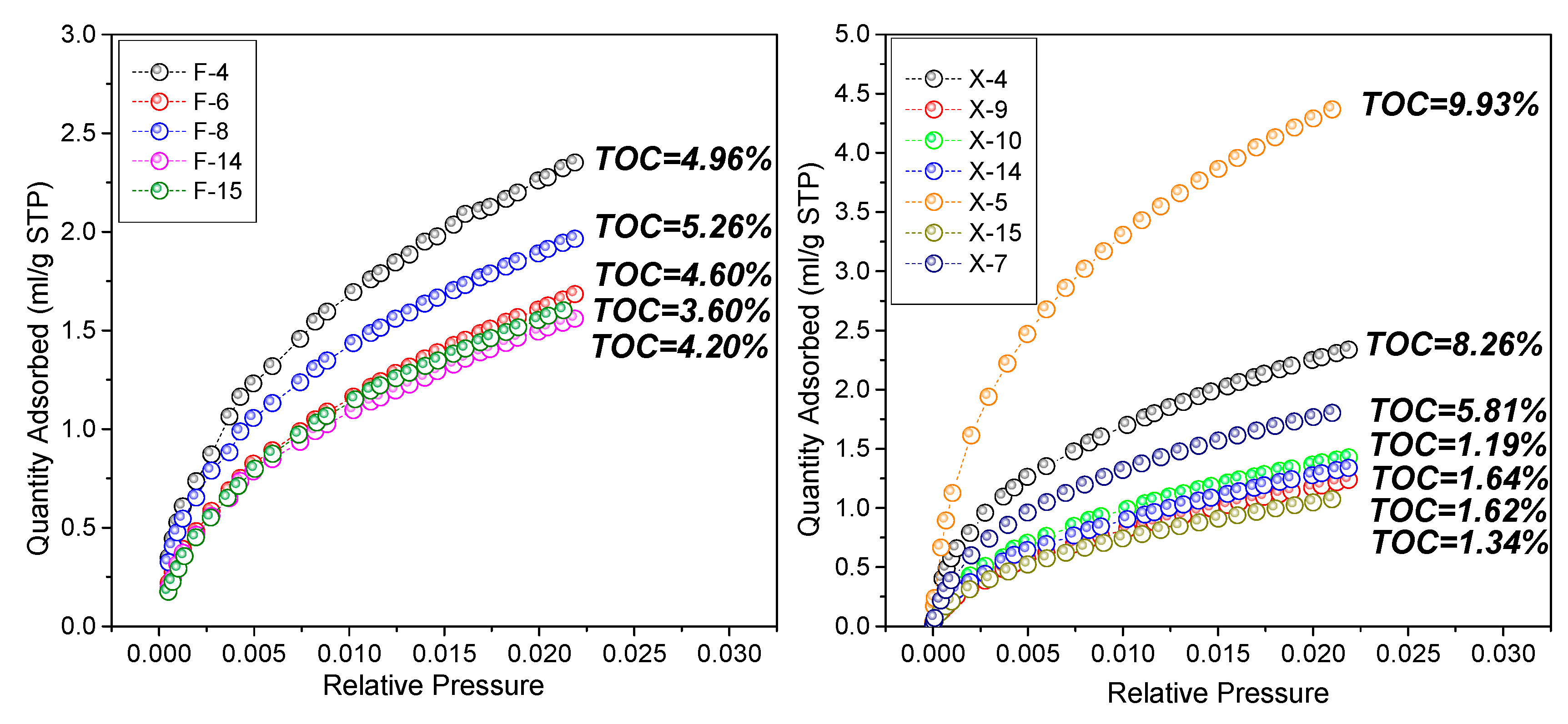
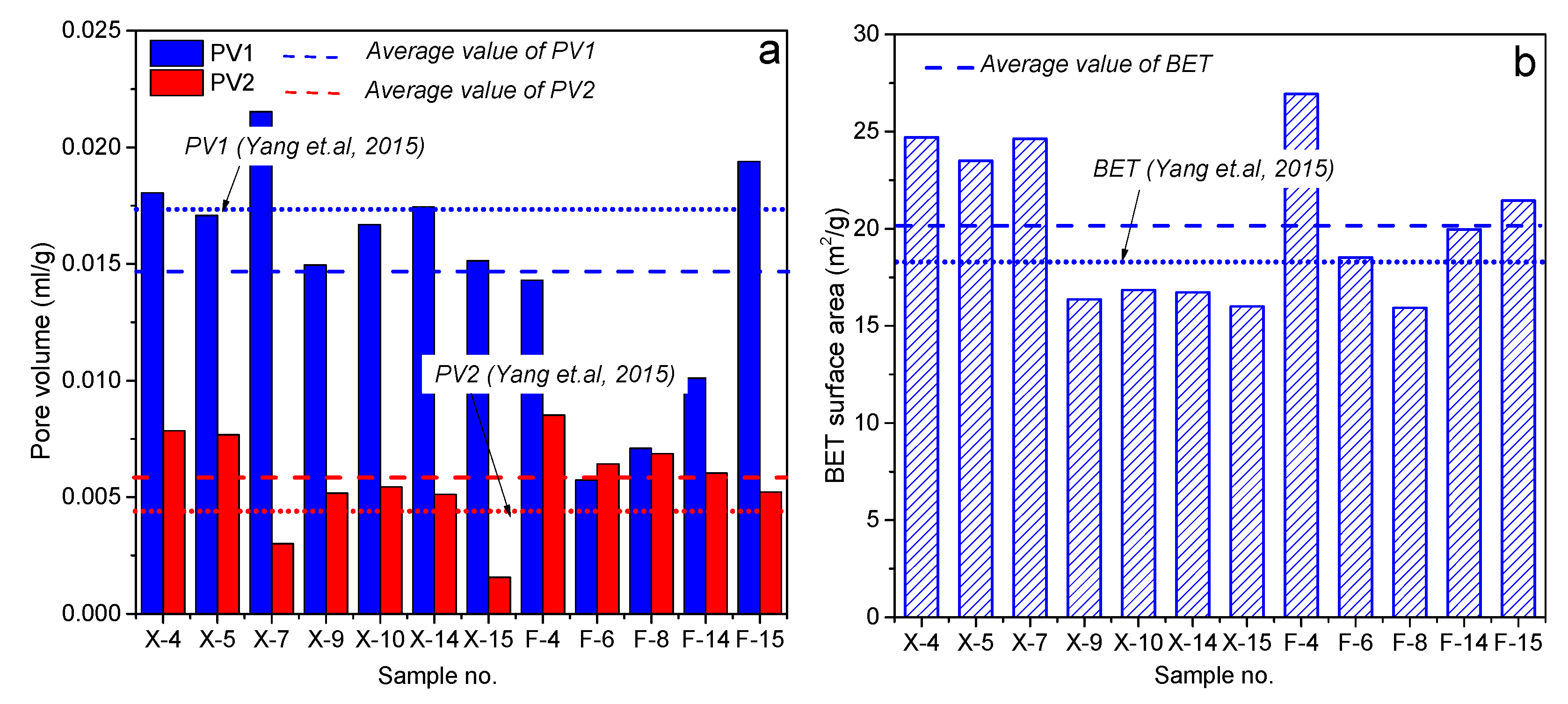
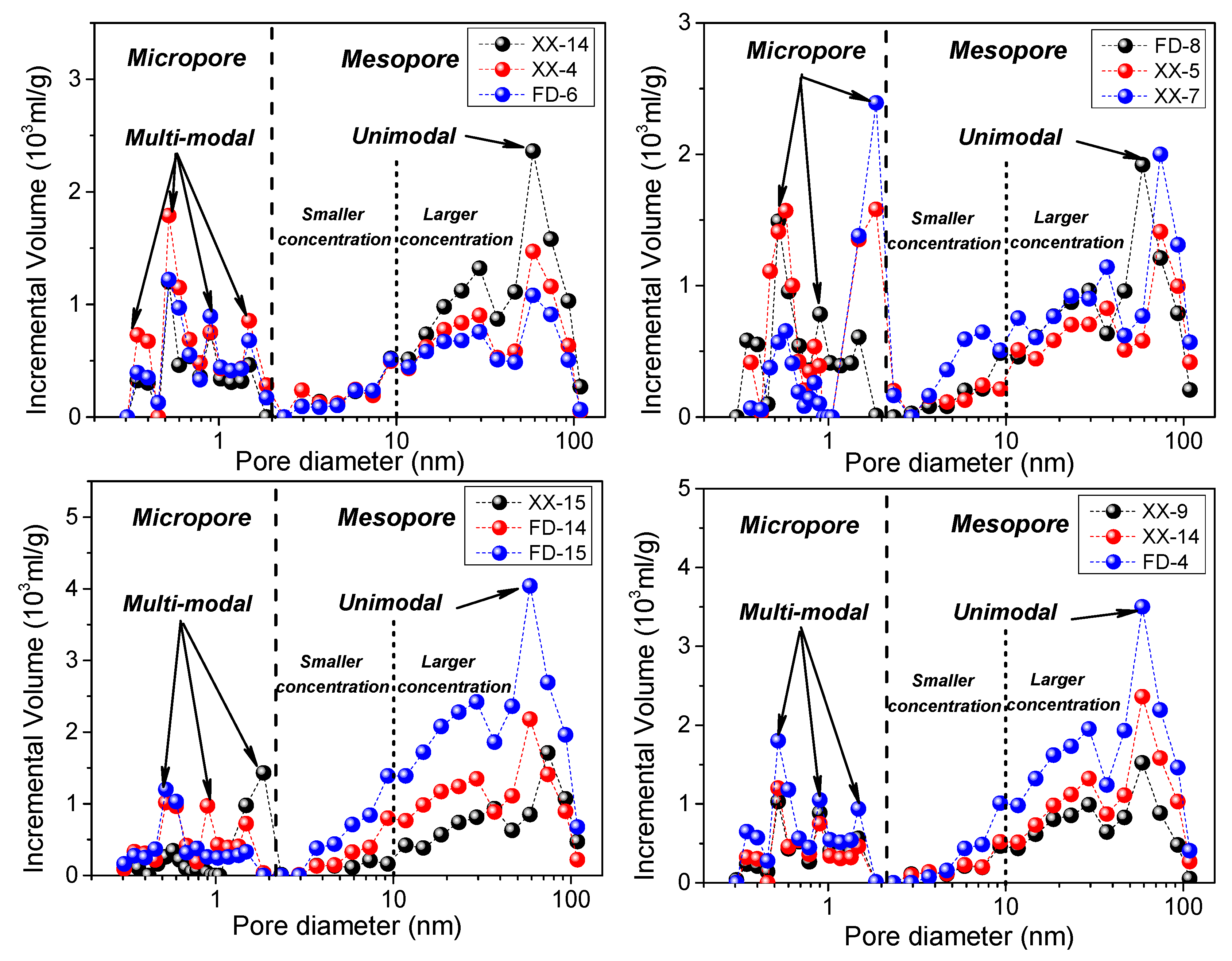
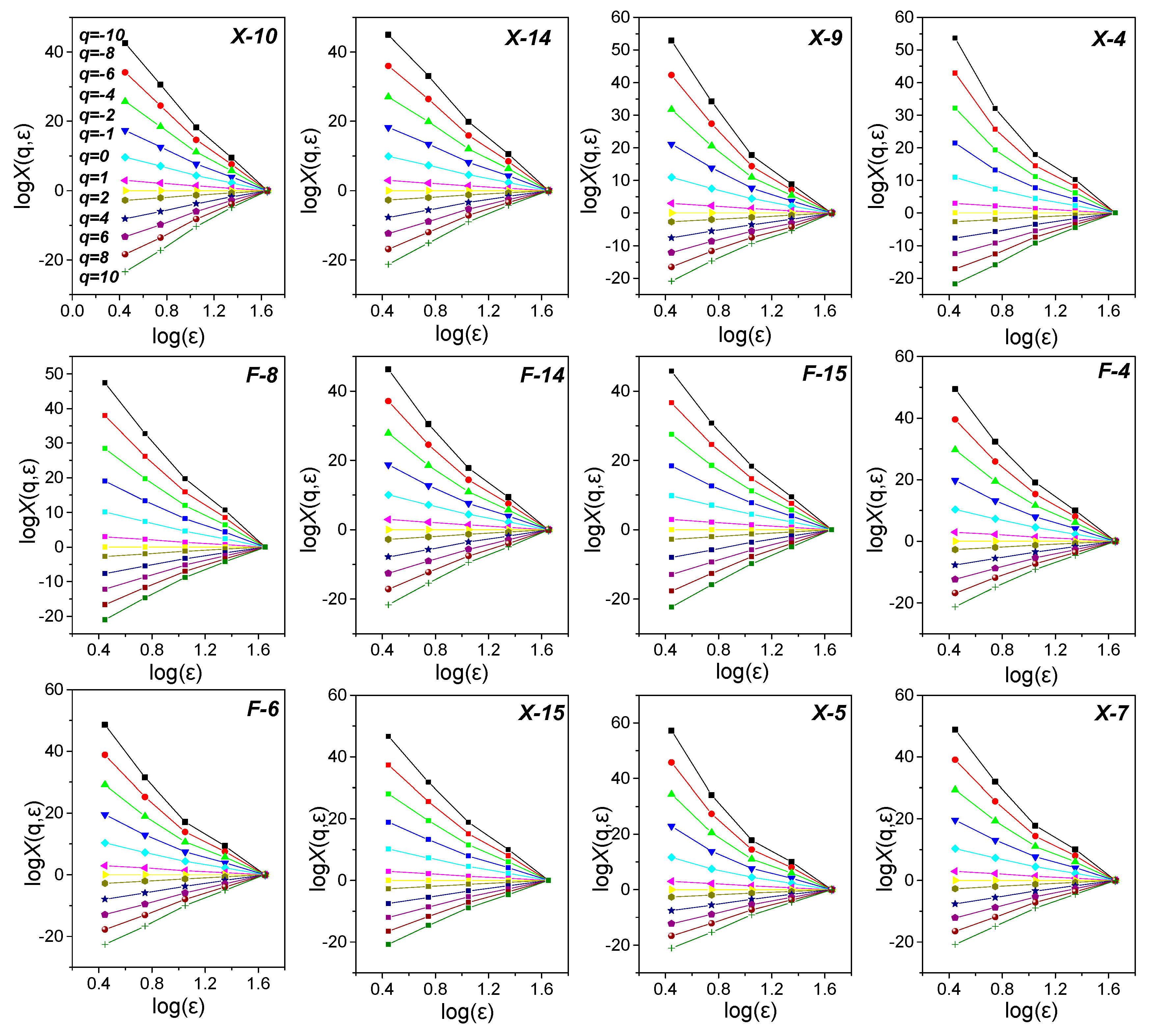
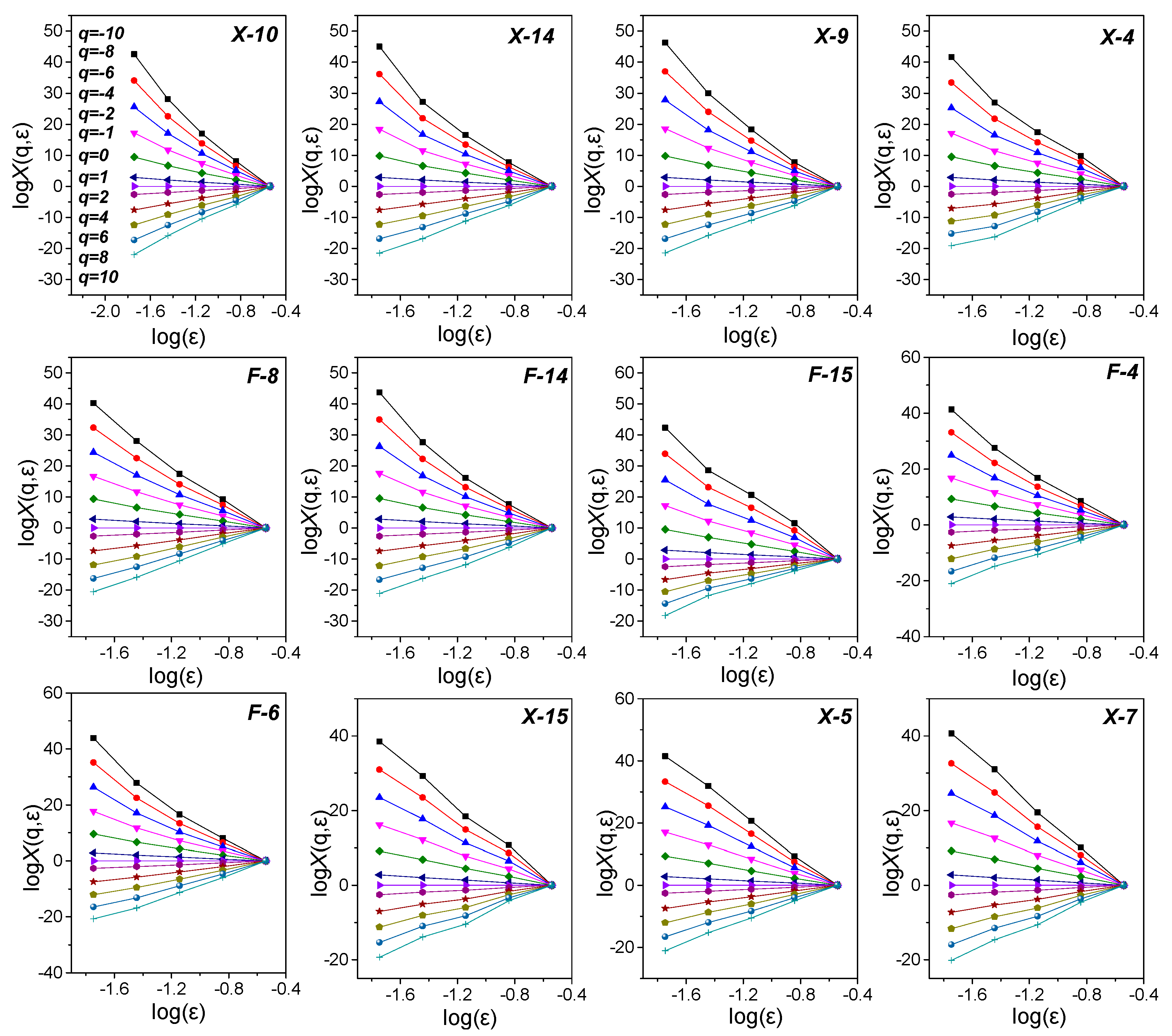
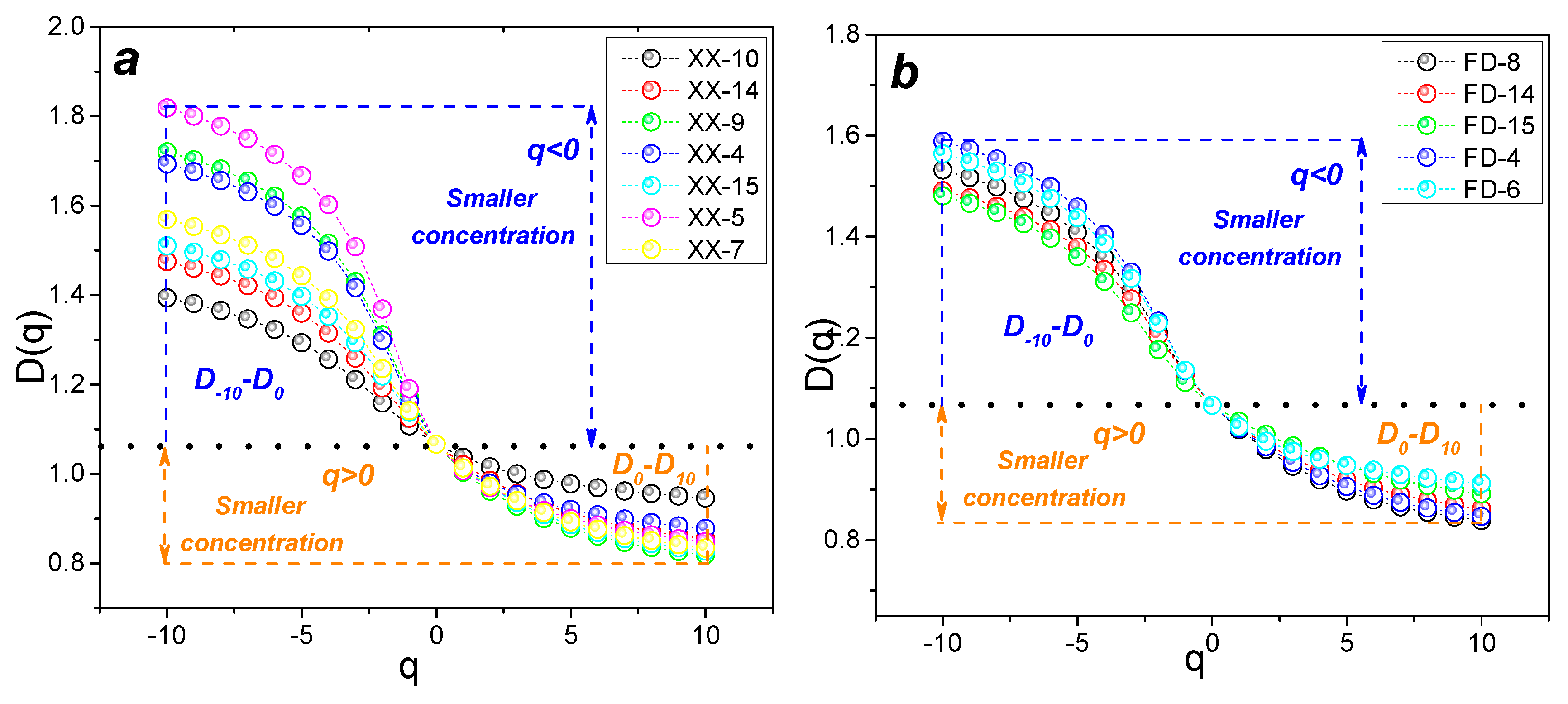
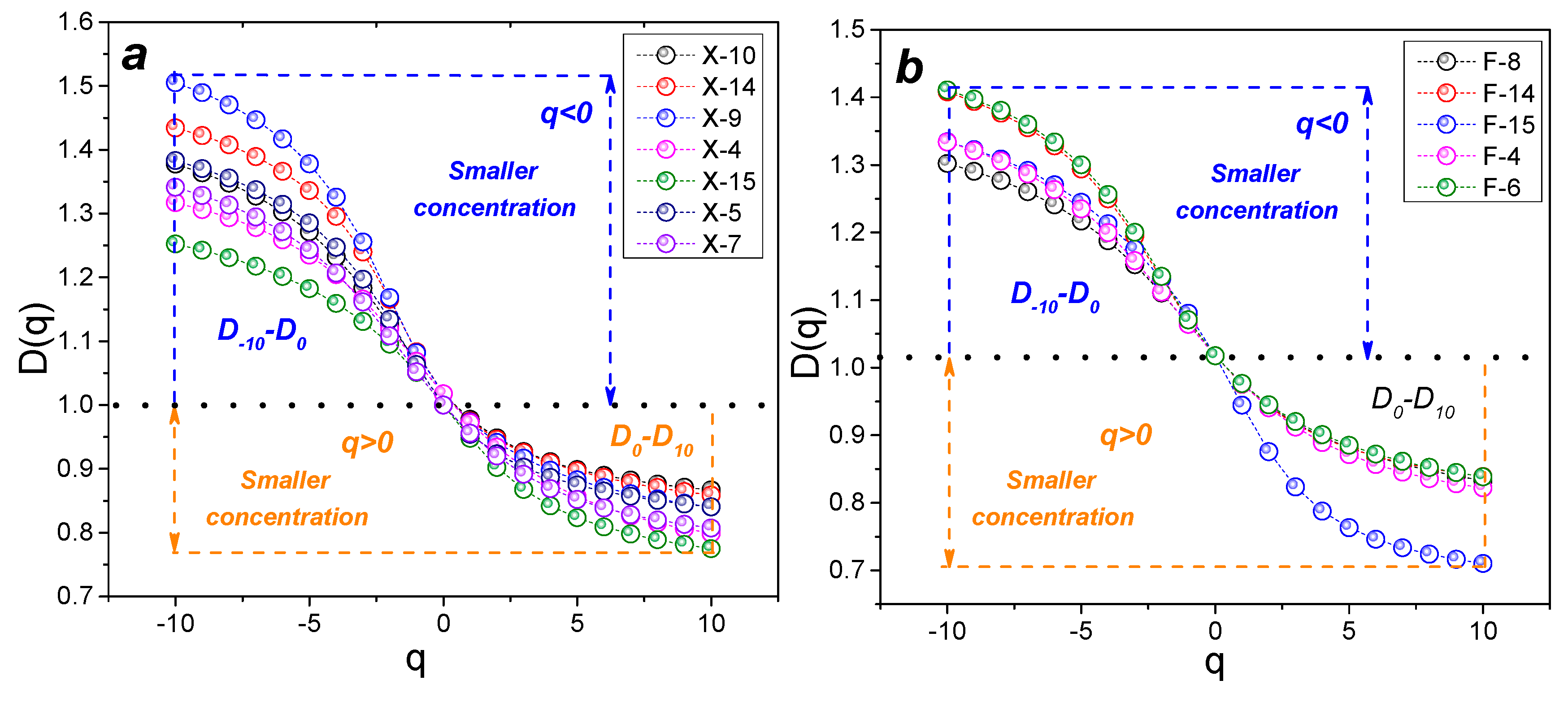
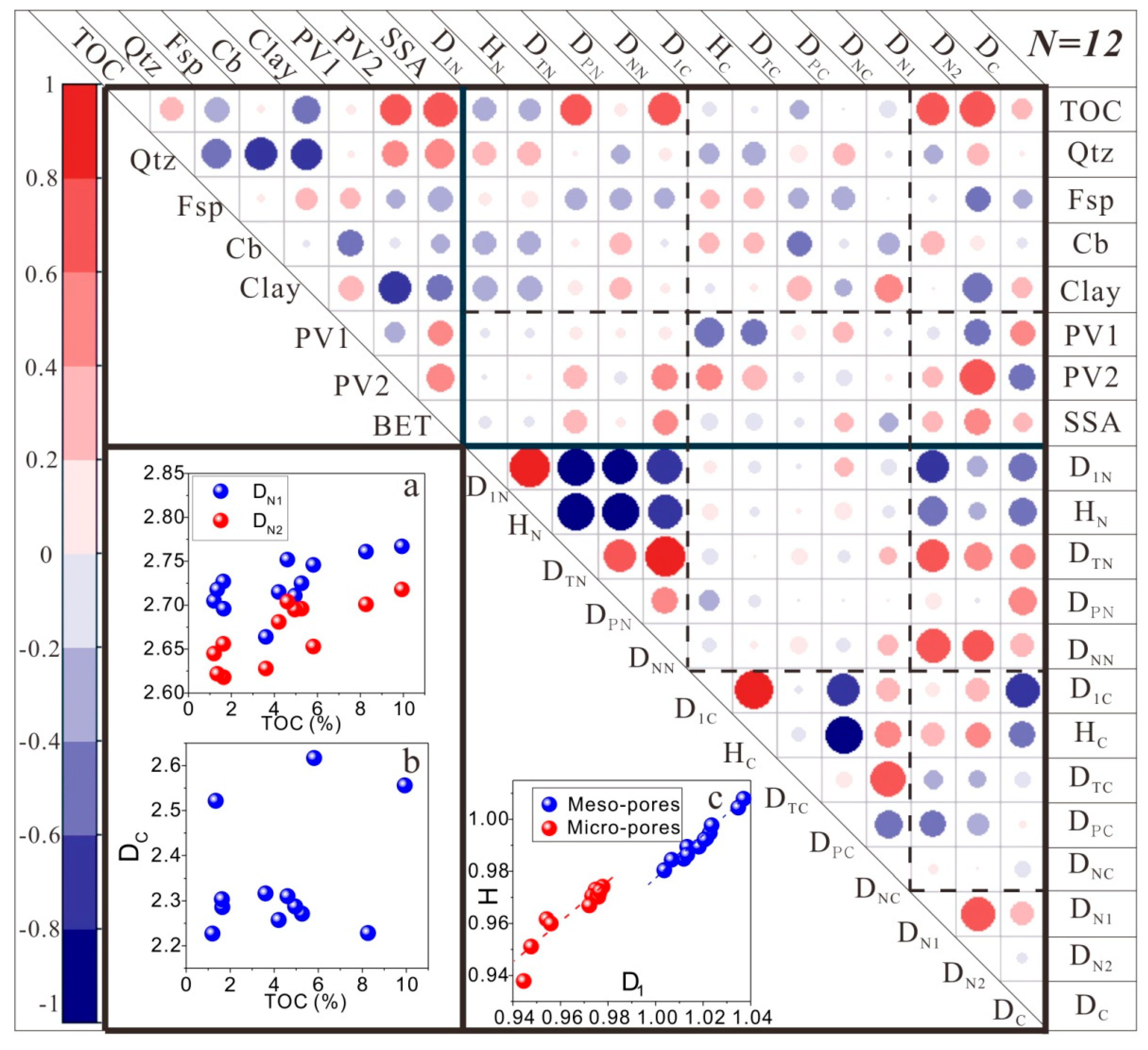
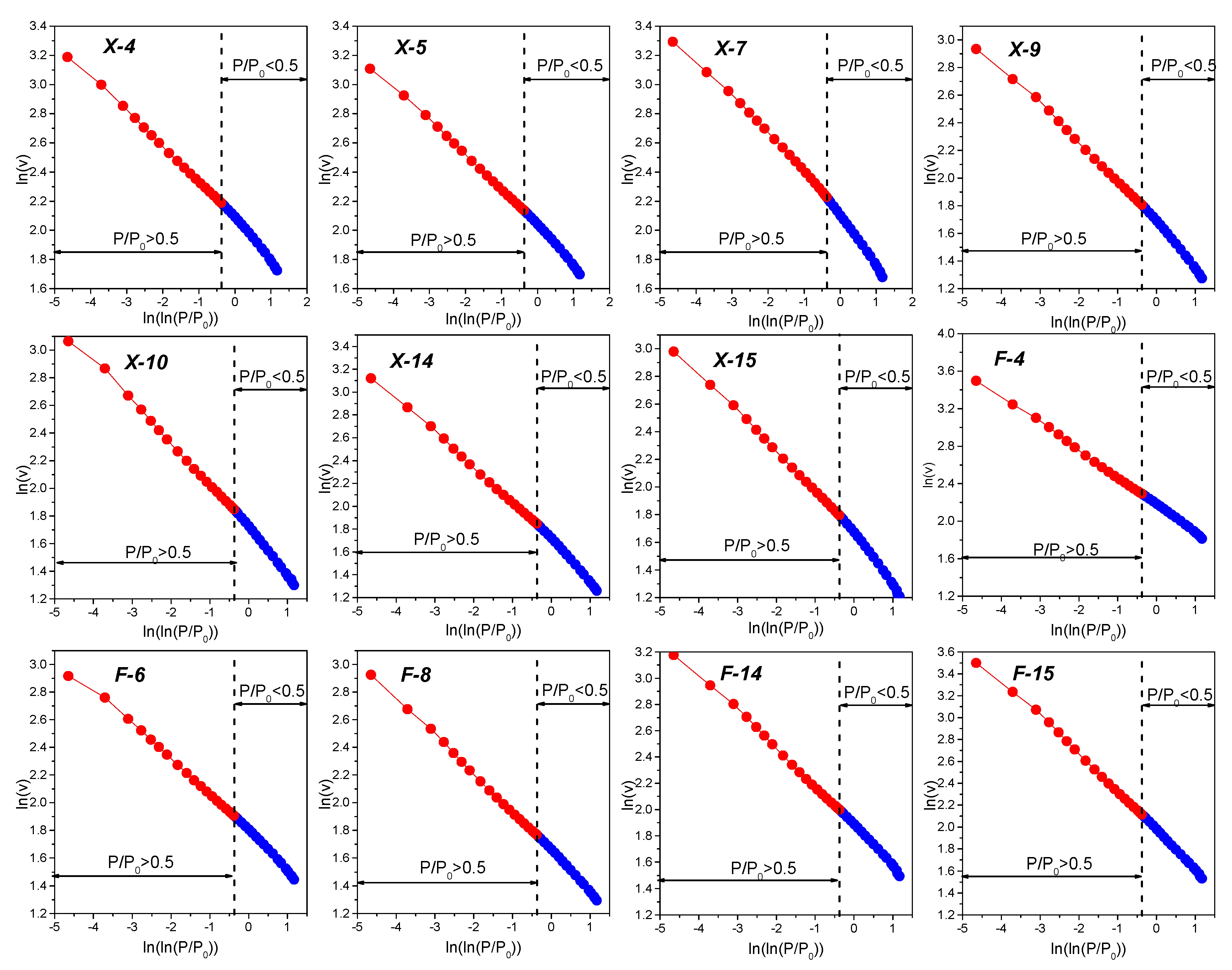
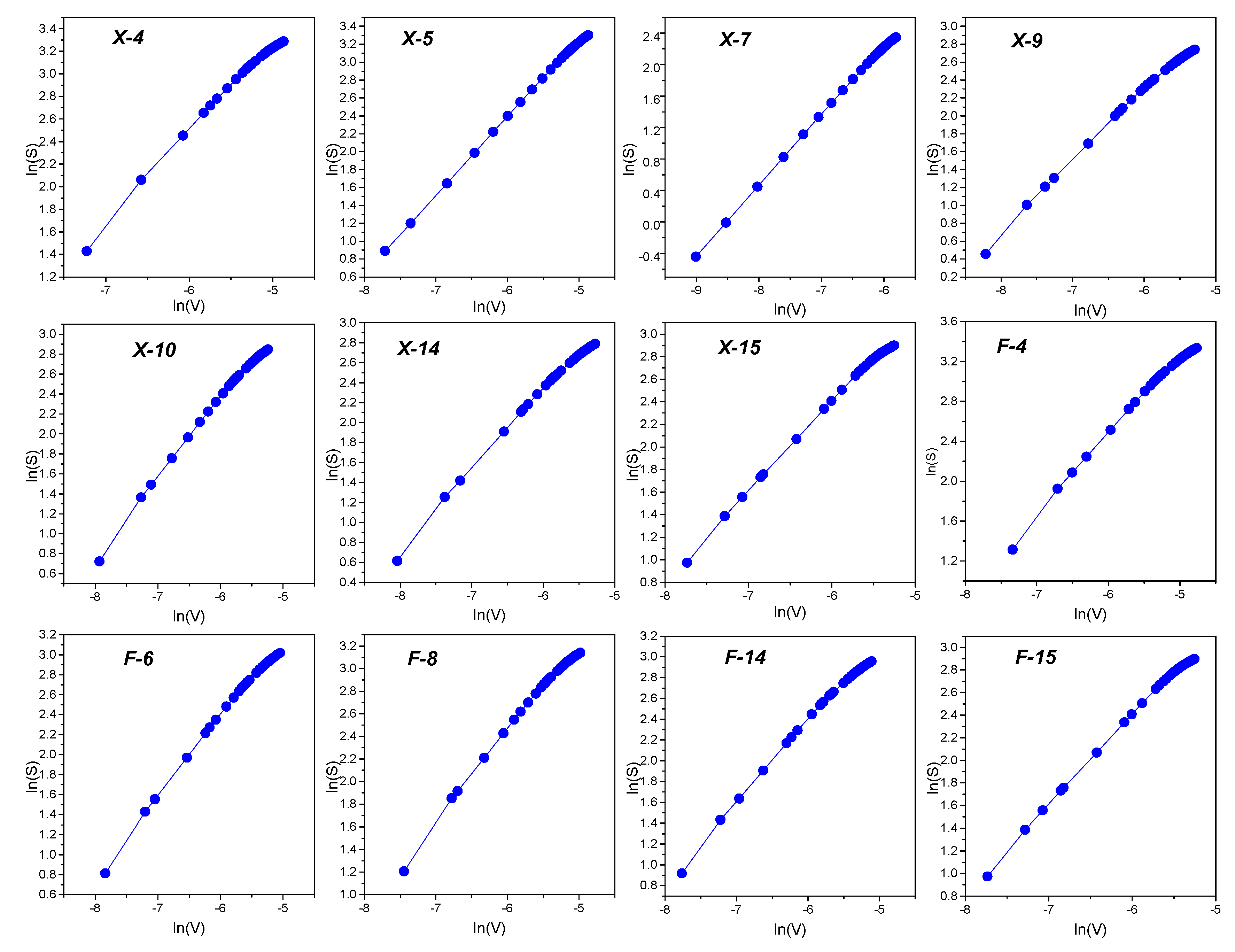



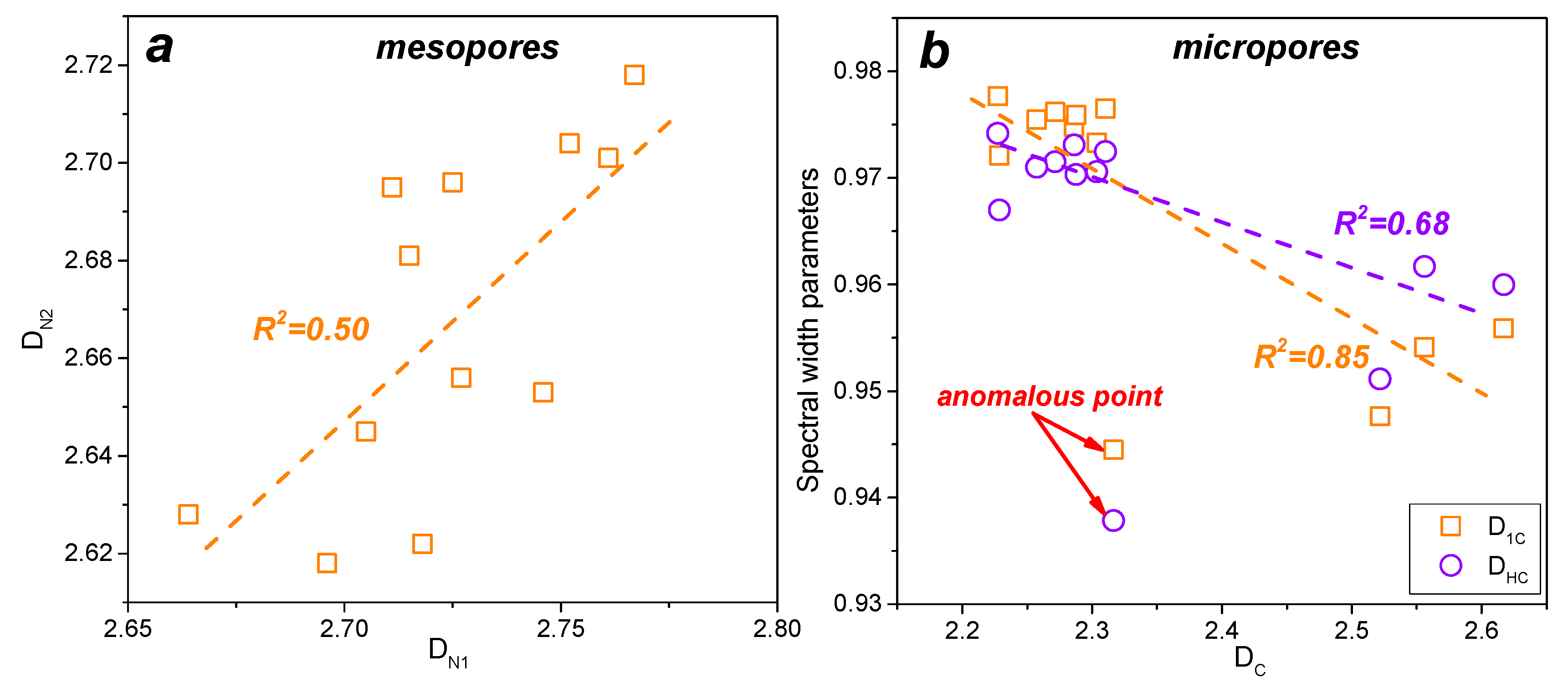

| Sample No. | TOC (%) | Mineralogical Compositions (%) | ||||||
|---|---|---|---|---|---|---|---|---|
| Quartz | Orthoclase | Plagioclase | Calcite | Dolomite | Pyrite | Clay | ||
| X-4 | 8.26 | 37.00 | 4.00 | 12.00 | 22.00 | 8.00 | - | 17.00 |
| X-5 | 9.93 | 77.00 | 3.00 | 4.00 | - | - | - | 16.00 |
| X-7 | 5.81 | 44.00 | 2.20 | 1.00 | 13.40 | 5.10 | 2.30 | 32.00 |
| X-9 | 1.62 | 36.80 | 1.10 | 6.40 | 6.70 | 5.20 | 1.60 | 42.20 |
| X-10 | 1.19 | 51.00 | 6.00 | 17.00 | - | - | - | 26.00 |
| X-14 | 1.64 | 34.00 | 10.00 | 10.00 | 20.00 | - | - | 26.00 |
| X-15 | 1.34 | 32.00 | 6.00 | 10.00 | 26.00 | - | - | 26.00 |
| F-4 | 4.95 | 76.10 | 0.50 | 2.70 | 5.80 | 3.80 | 0.90 | 10.20 |
| F-6 | 4.60 | 52.40 | 0.50 | 3.10 | 16.00 | 7.80 | 4.30 | 15.90 |
| F-8 | 5.26 | 42.50 | 0.50 | 4.10 | 18.40 | 14.90 | 3.60 | 16.00 |
| F-14 | 4.20 | 62.00 | - | 5.00 | 6.00 | 13.00 | - | 14.00 |
| F-15 | 3.60 | 83.00 | - | 1.00 | - | - | - | 16.00 |
| Sample No. | Mesopores | Microporous | |||||||||||
|---|---|---|---|---|---|---|---|---|---|---|---|---|---|
| D1N | HN | DTN | DPN | DNN | DN1 | DN2 | D1C | HC | DTC | DPC | DNC | DC | |
| X-4 | 1.01 | 0.99 | 0.81 | 0.19 | 0.63 | 2.76 | 2.70 | 0.97 | 0.97 | 0.52 | 0.22 | 0.30 | 2.23 |
| X-5 | 1.01 | 0.98 | 0.97 | 0.22 | 0.75 | 2.77 | 2.72 | 0.95 | 0.96 | 0.54 | 0.16 | 0.38 | 2.56 |
| X-7 | 1.01 | 0.99 | 0.74 | 0.23 | 0.50 | 2.75 | 2.65 | 0.96 | 0.96 | 0.53 | 0.19 | 0.34 | 2.62 |
| X-9 | 1.00 | 0.98 | 0.90 | 0.25 | 0.65 | 2.73 | 2.66 | 0.97 | 0.97 | 0.66 | 0.18 | 0.49 | 2.30 |
| X-10 | 1.04 | 1.01 | 0.45 | 0.12 | 0.33 | 2.71 | 2.65 | 0.98 | 0.97 | 0.51 | 0.15 | 0.36 | 2.23 |
| X-14 | 1.02 | 0.99 | 0.62 | 0.21 | 0.41 | 2.70 | 2.62 | 0.97 | 0.97 | 0.58 | 0.16 | 0.42 | 2.29 |
| X-15 | 1.01 | 0.98 | 0.68 | 0.24 | 0.44 | 2.72 | 2.62 | 0.95 | 0.95 | 0.48 | 0.23 | 0.25 | 2.52 |
| F-4 | 1.02 | 0.99 | 0.74 | 0.22 | 0.52 | 2.71 | 2.70 | 0.98 | 0.97 | 0.51 | 0.20 | 0.32 | 2.29 |
| F-6 | 1.02 | 1.00 | 0.65 | 0.15 | 0.50 | 2.75 | 2.70 | 0.98 | 0.97 | 0.57 | 0.18 | 0.39 | 2.31 |
| F-8 | 1.02 | 0.99 | 0.69 | 0.23 | 0.47 | 2.73 | 2.70 | 0.98 | 0.97 | 0.47 | 0.18 | 0.28 | 2.27 |
| F-14 | 1.02 | 0.99 | 0.63 | 0.21 | 0.42 | 2.72 | 2.68 | 0.98 | 0.97 | 0.57 | 0.18 | 0.39 | 2.26 |
| F-15 | 1.03 | 1.00 | 0.59 | 0.18 | 0.41 | 2.66 | 2.63 | 0.94 | 0.94 | 0.62 | 0.31 | 0.32 | 2.32 |
| Sample No. | P/P0 > 0.5 | P/P0 < 0.5 | ||||
|---|---|---|---|---|---|---|
| Fitting Equation | R2 | D1 | Fitting Equation | R2 | D2 | |
| X-4 | y = −0.239x + 2.097 | 0.999 | 2.761 | y = −0.299x + 2.092 | 0.996 | 2.701 |
| X-5 | y = −0.233x + 2.049 | 0.999 | 2.767 | y = −0.282x + 2.042 | 0.997 | 2.718 |
| X-7 | y = −0.254x + 2.151 | 0.997 | 2.746 | y = −0.347x + 2.105 | 0.998 | 2.653 |
| X-9 | y = −0.273x + 1.705 | 0.998 | 2.727 | y = −0.344x + 1.691 | 0.998 | 2.656 |
| X-10 | y = −0.295x + 1.734 | 0.998 | 2.705 | y = −0.355x + 1.725 | 0.999 | 2.645 |
| X-14 | y = −0.304x + 1.729 | 0.999 | 2.696 | y = −0.382x + 1.719 | 0.998 | 2.618 |
| X-15 | y = −0.282x + 1.690 | 0.999 | 2.718 | y = −0.378x + 1.671 | 0.996 | 2.622 |
| F-4 | y = −0.289x + 2.177 | 0.998 | 2.711 | y = −0.305x + 2.185 | 0.998 | 2.695 |
| F-6 | y = −0.248x + 1.816 | 0.997 | 2.752 | y = −0.296x + 1.806 | 0.997 | 2.704 |
| F-8 | y = −0.275x + 1.656 | 0.999 | 2.725 | y = −0.304x + 1.661 | 0.998 | 2.696 |
| F-14 | y = −0.285x + 1.889 | 0.998 | 2.715 | y = −0.319x + 1.889 | 0.996 | 2.681 |
| F-15 | y = −0.336x + 1.990 | 0.997 | 2.664 | y = −0.372x + 1.980 | 0.999 | 2.628 |
| Sample No. | Fitting Equation | R2 | D | Sample No. | Fitting Equation | R2 | D |
|---|---|---|---|---|---|---|---|
| X-4 | y = 0.742x + 6.941 | 0.979 | 2.229 | X-15 | y = 0.840x + 7.159 | 0.999 | 2.522 |
| X-5 | y = 0.852x + 7.487 | 0.998 | 2.556 | F-4 | y = 0.762x + 7.037 | 0.994 | 2.288 |
| X-7 | y = 0.872x + 7.451 | 0.999 | 2.617 | F-6 | y = 0.770x + 6.978 | 0.995 | 2.310 |
| X-9 | y = 0.767x + 6.874 | 0.996 | 2.304 | F-8 | y = 0.757x + 6.979 | 0.994 | 2.271 |
| X-10 | y = 0.764x + 6.916 | 0.995 | 2.227 | F-14 | y = 0.752x + 6.872 | 0.995 | 2.257 |
| X-14 | y = 0.762x + 6.872 | 0.995 | 2.286 | F-15 | y = 0.772x + 7.013 | 0.997 | 2.316 |
| Sample No. | Transport Rate of N2 (cm³/(g·min)) | Transport Rate of CO2 (cm³/(g·min)) |
|---|---|---|
| X-4 | 0.037 | 0.009 |
| X-5 | 0.034 | 0.017 |
| X-7 | 0.029 | 0.008 |
| X-9 | 0.037 | 0.003 |
| X-10 | 0.059 | 0.009 |
| X-14 | 0.049 | 0.003 |
| X-15 | 0.047 | 0.004 |
| F-4 | 0.052 | 0.005 |
| F-6 | 0.033 | 0.008 |
| F-8 | 0.031 | 0.009 |
| F-14 | 0.042 | 0.005 |
| F-15 | 0.071 | 0.020 |
© 2020 by the authors. Licensee MDPI, Basel, Switzerland. This article is an open access article distributed under the terms and conditions of the Creative Commons Attribution (CC BY) license (http://creativecommons.org/licenses/by/4.0/).
Share and Cite
Wang, X.; Zhu, Y.; Wang, Y. Fractal Characteristics of Micro- and Mesopores in the Longmaxi Shale. Energies 2020, 13, 1349. https://doi.org/10.3390/en13061349
Wang X, Zhu Y, Wang Y. Fractal Characteristics of Micro- and Mesopores in the Longmaxi Shale. Energies. 2020; 13(6):1349. https://doi.org/10.3390/en13061349
Chicago/Turabian StyleWang, Xiaoqi, Yanming Zhu, and Yang Wang. 2020. "Fractal Characteristics of Micro- and Mesopores in the Longmaxi Shale" Energies 13, no. 6: 1349. https://doi.org/10.3390/en13061349
APA StyleWang, X., Zhu, Y., & Wang, Y. (2020). Fractal Characteristics of Micro- and Mesopores in the Longmaxi Shale. Energies, 13(6), 1349. https://doi.org/10.3390/en13061349





